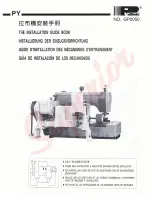
Using the Memory Function
74
g
Reposition the fabric in embroidery frame so that the
right side of the letter “C” will be partially inside the
embroidery frame; being careful so letters remain
straight and level. Then reattach frame again so that
the remaining characters (“DEF”) can be embroidered.
h
Press
to cancel the current character patterns.
i
Select the character patterns for “DEF”, and then press
and
.
j
Press .
k
Press
, and then press
.
The needle is positioned in the lower-left corner of
the pattern. The embroidery frame moves so that the
needle is positioned correctly.
l
Use
to align the needle with the end of the
embroidering for the previous pattern.
m
Press .
n
Lower the embroidery foot and press the “Start/Stop”
button to begin embroidering the remaining character
patterns.
■
Embroidery data precautions
Types of embroidery data that can be used
Only .pes, .phc, and .dst embroidery data files can be
used with this machine. Using data other than that saved
using our data design systems or machines may cause the
machine to malfunction.
Embroidery pattern size
This machine is compatible with embroidery patterns up
to a maximum of 10 cm × 10 cm (4 inches × 4 inches).
USB flash drive
USB flash drive is commercially available, but some USB
flash drives may not be usable with this machine. Please
visit our website “ http://s.brother/cpjab ” for more details.
Precautions on using the computer to create and save
data
We recommend using the 26 letters of the alphabet
(uppercase and lowercase), the numbers 0 through 9,”-”,
and “_” for the name of the file/folder.
Tajima (.dst) embroidery data
• .dst data is displayed in the pattern list screen by file
name (the actual thumbnail image cannot be
displayed).
• Since Tajima (.dst) data does not contain specific
thread color information, it is displayed with our
default thread color sequence. Check the preview and
change the thread colors as desired.
Using the Memory Function
CAUTION
• When using embroidery data other than our
original patterns, the thread or needle may
break when embroidering with a stitch density
that is too fine or when embroidering three or
more overlapping stitches. In that case, use
one of our original data design systems to edit
the embroidery data.
Summary of Contents for 888-M20
Page 2: ...Cover2 3 PANTONE 285 C K ...
Page 36: ...Useful Sewing Tips 34 ...
Page 58: ...Using The Memory Function 56 ...
Page 78: ...Using the Memory Function 76 ...
Page 94: ......
Page 95: ......
Page 96: ......
Page 97: ......
Page 98: ......
Page 99: ...Cover2 3 PANTONE 285 C K ...
















































